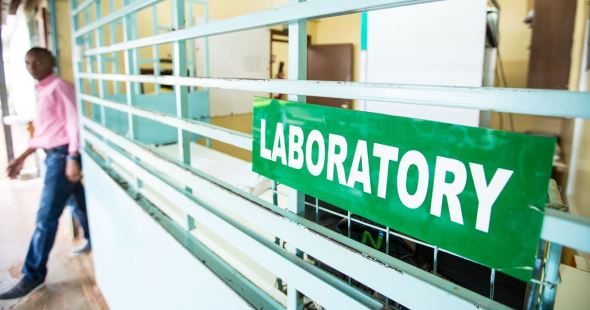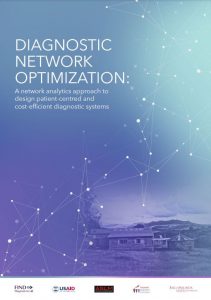Diagnostic network optimization

What is this project?
Diagnostic network optimization aims to understand how diagnostic services are organized in a country to inform the optimal location of tools, testing capacity and sample referral systems. It uses national data to understand existing gaps that limit access to and utilization of diagnostic services, and to design the best solutions to address these gaps.
Why are we working on it?
Lack of access to testing can occur either because diagnostic services are unavailable, or the location of these services is misaligned with where patients live and their care-seeking behaviour. Diagnostic services in low- and middle-income countries (LMICs) are often further challenged by poor laboratory infrastructure, limited skilled human resources, lack of equipment, inadequate quality assurance programs, and weak supply chains for reagents and consumables that are needed to perform the tests.
Network design that is better aligned with patient health seeking behaviour is expected to help alleviate barriers to care and assist governments and donors to improve the efficiency of investments and service delivery.
What does it involve?
Since 2016, FIND has been collaborating with LLamasoft and Ministries of Health in Kenya, Lesotho and Philippines to conduct diagnostic network design and optimization exercises, using LLamasoft’s proprietary supply chain management optimization software. In these countries the diagnostic network design and optimization exercises focused on designing network models that would enable the countries to find their “missing” tuberculosis (TB) cases, improve detection of drug resistance and reach their End TB targets. This was achieved by determining the optimal footprint and placement of TB diagnostic technologies and streamlining referral linkages.
The work highlighted the need to build capacity across LMICs to conduct similar analyses through a user-friendly software specifically designed to address optimization questions for diagnostic networks.
Following the successful work in Kenya, Lesotho and Philippines that fed into national strategic planning processes, FIND in collaboration with LLamasoft and USAID Global Health Supply Chain Program-Procurement and Supply Management (GHSC-PSM), has developed an open-access diagnostic network optimization tool, OptiDx, to allow more countries to benefit from this approach.
OptiDx is based on the LLamasoft software and can be used to guide the placement of diagnostic capacity and referral networks for TB, HIV and other diseases. It has been designed specifically for LMICs, and uses existing sources of country-specific data, including case-notification reports, testing statistics, epidemiological, demographic surveys and population data, as well as geographical parameters. OptiDx enables the user to run a series of customizable scenarios aimed at improving access and cost efficiency of services.
What do we expect to achieve?
In Kenya, findings from the network analysis fed directly into the national strategic plan for TB that was launched in 2019. The optimization has informed the design of the network, including required capacity and placement of molecular testing (GeneXpert) devices and referral linkages to meet National Strategic Plan (NSP) targets. Follow-on work focused on country-level planning for integrated sample referral networks and TB–HIV integration on molecular testing platforms and the development of an operational planning guide.
In the Philippines, the model output has been used by the National TB Program as a guide in procuring and allocating molecular testing machines in 2020–2022. The analysis showed that the same impact could be achieved with procurement of less than 50% of the planned instruments and an optimized network design.
Diagnostic network optimization exercises in India, Central African Republic and Gambia are ongoing, including the design of integrated testing and sample referral for TB, HIV and neglected tropical diseases, among others.
Following the completion of the development of OptiDx, pilots will take place to inform global guidance for LMICs on the diagnostic network optimization process and use of the OptiDx tool, with the aim of this approach becoming an accepted component of network planning across diseases in LMICs to guide investment decisions.
What is the timescale?
The OptiDx pilots will take place from Q3 2020 until Q1 2021. OptiDx will be made freely available to countries in 2021 and will be maintained for an initial 3-year period.
Partners and funding
Diagnostic network optimization work in Kenya, Philippines and India and development of the open-access network optimization tool (OptiDx) by FIND and LLamasoft is supported by the Bill & Melinda Gates Foundation through a grant to FIND. Hosting and maintenance of the OptiDx tool will be supported by U.S. President’s Emergency Plan for AIDS Relief (PEPFAR) via the USAID Global Health Supply Chain Program-Procurement and Supply Management (GHSC-PSM) project.
Ongoing work in Central Africa Republic and the Gambia is being supported by the Global Fund.
More information
Nichols K, Girdwood SJ, Inglis A, et al. Bringing Data Analytics to the Design of Optimized Diagnostic Networks in Low- and Middle-Income Countries: Process, Terms and Definitions. Diagnostics 2021, 11(1),22; https://doi.org/10.3390/diagnostics11010022
For more information please contact us.


